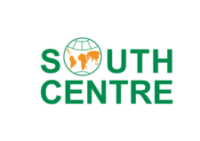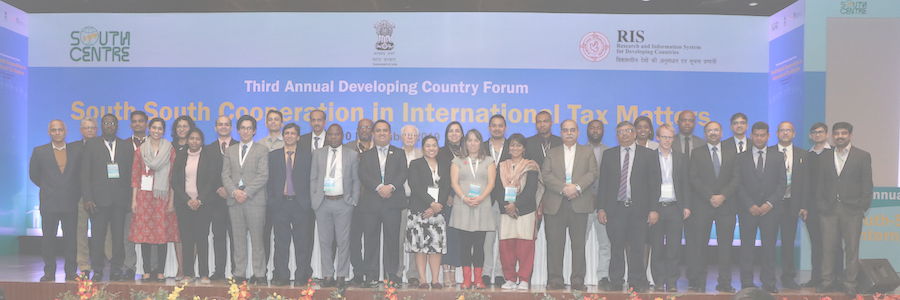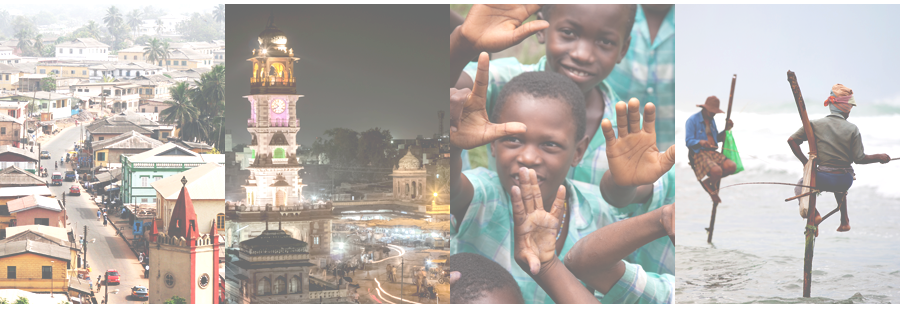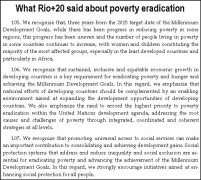SDGs: Poverty Eradication
[South Centre Paper on Sustainable Development Goals]
This is a brief paper on conceptual aspects of poverty eradication as an issue for the SDGs.
In line with our overall approach to the SDGs, the issue of poverty eradication should have goals and targets for countries but also for the international dimension, which includes the Global Partnership for Development (that involves policies relating to global macro-economics, debt, trade, finance, and access to technology) and the means of implementation (i.e. finance and technology for developing countries).
Poverty eradication has economic, social and environmental dimensions. We should have an overall goal of eradicating poverty as soon as possible. One priority is to eliminate extreme poverty altogether by a certain date to be determined. Another is to very significantly reduce poverty (measured for example by income of two dollars a day) by a target date. To do this, we need to tackle the economic roots of poverty. There should also be social and environmental related measures.
On the economic pillar, poverty eradication requires generation of employment, which includes jobs in the urban areas and livelihoods in the rural areas. This requires job-intensive economic growth. Economic growth in turn requires: (1) macro-economic policies that are oriented towards growth and job creation, including fiscal and monetary policies that place highest priority on growth, employment and development; (2) longer-term development policies that involve the development of productive capacity of developing countries in industry, agriculture and services; (3) the development, transfer and access to affordable technology in developing countries.
However developing countries can implement such economic policies only if they are supported by a positive and enabling international environment.
The international environment or international institutions and factors had previously placed conditions or rules that had adverse impacts on developing countries. This had been done through loan conditionalities (that included structural adjustment policies), aid conditionalities, and some of the rules in WTO and bilateral trade and investment agreements. Some examples of international factors that have impacted on poverty in developing countries are as follows:
- In the past many developing countries had been affected by structural adjustment policies that included growth-contracting macro-economic policies, better known today as austerity measures including severe budget cuts that depressed effective demand and prevented spending for social development; these austerity measures are still advocated by the IMF to many developing countries.
- The structural adjustment policies also included sudden and extreme trade liberalisation policies that reduced tariffs in developing countries, which led to the closure or reduction of small farms and local industries in many developing countries. The loss of jobs and livelihoods was a major cause of poverty. This extreme import liberalisation is still on the agenda of free trade agreements, that asks the developing countries to cut 80 to 100 per cent of all their tariffs to zero, over a ten-year implementation period, with a significant number upfront.
- The TRIPS agreement in the WTO also mandated that developing countries introduce strict IPR regimes, that affected prices of essentials especially medicines, making some of them beyond the reach of the low and middle income groups.
- The global financial crisis in 2007-2010 that originated in the Western countries had a significant adverse effect on developing countries through reduction in exports, fall in commodity prices, reduced tourism, and reduced commercial credit. The growth rates of most developing countries were significantly reduced.
Therefore there should also be goals at the level of the international system that include: (1) loan and aid conditions including during bailouts that provide policy space to be provided to developing countries to have macro-economic policies and fiscal policies that give priority to growth and social development, and not one-dimensional in inflation-targeting or “austerity policies” and steep cuts in budgets; (2) a favourable trading system including multilateral trade rules and bilateral/regional trade arrangements, that are oriented towards the needs of the poor (such as small farmers and the urban poor) in developing countries; thus goals such as promoting small farmers’ livelihoods, food security and rural development and permitting subsidies for poor farmers in developing countries in trade rules are important; (3) sufficient financing for development, including during periods of external shocks or unfavourable conditions such as commodity price declines and natural disasters; (4) establishing an effective system for resolution of external debt problems in developing countries; (5) international mechanism to assist developing countries address significant falls in commodity prices; (6) international mechanisms to assist developing countries affected by the global recessionary conditions.
On the social pillar, poverty eradication can be addressed by high priority to be given to social development. This includes public-sector spending on health, education, food security, water and a policy to employment generation and rural livelihoods. There should be adequate supply of social services. An aspiration is the universal access of the public to basic services such as health care and education, and to food. A method is for the government to provide income transfers or the provision of food and health care which are targeted at the poor families, as introduced in some countries. However we must recognise that such an aspiration to universal access to services or to such transfers is dependent on the governments of developing countries having (1) adequate policy space that is not hindered by inappropriate loan and aid conditionalities, including austerity measures; and (2) the required funds. If such funds are not available, then the international dimension becomes critical. Thus there should also be goals for the international system to support and enable developing countries to address the social dimensions of poverty eradication. The setting up of an international social fund to finance social programmes in developing countries, such as that proposal by the Special Rapporteur on the right to food, is worth considering. Another proposal is to develop or expand international initiatives to enable access to affordable medicines, and access to knowledge and information.
On the environmental pillar, we should recognise that the poor are often most vulnerable to the effects of pollution and resource depletion or scarcity. We could therefore consider the issue of sheltering the poor and vulnerable groups from the effects of environmental damage. However many developing countries do not have the adequate resources to adequately address environmental issues as they do not want to divert scarce funds away from social development or economic goals. Therefore the means of implementation are also crucial for them to address the environmental dimension of poverty eradication.
Besides these issues above, which combine goals for countries to aspire to, and global-level goals to support the efforts of developing countries, we believe there should also be a separate section in the issue of poverty eradication devoted to means of implementation, i.e. the provision of international financial resources and technology access and transfer. This section could include the issues raised above such as sufficient financing for development, debt issues, meeting the financing shortfall of countries affected by the global economic recession, as well as the provision of technology to support the growth of productive capacity and thus the generation of jobs.













